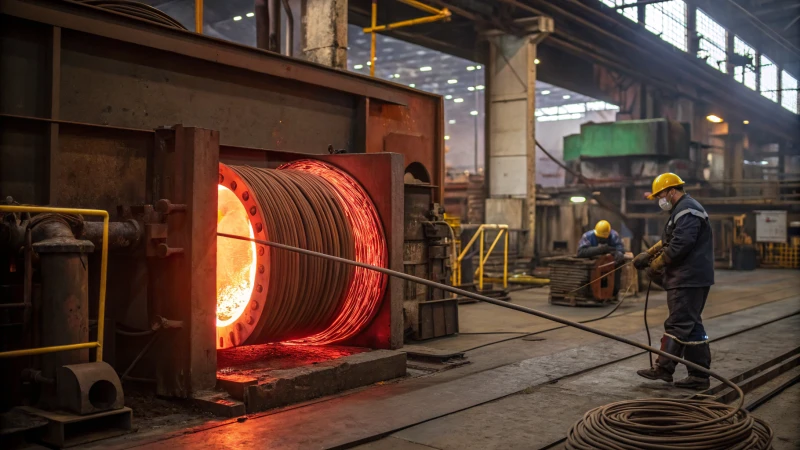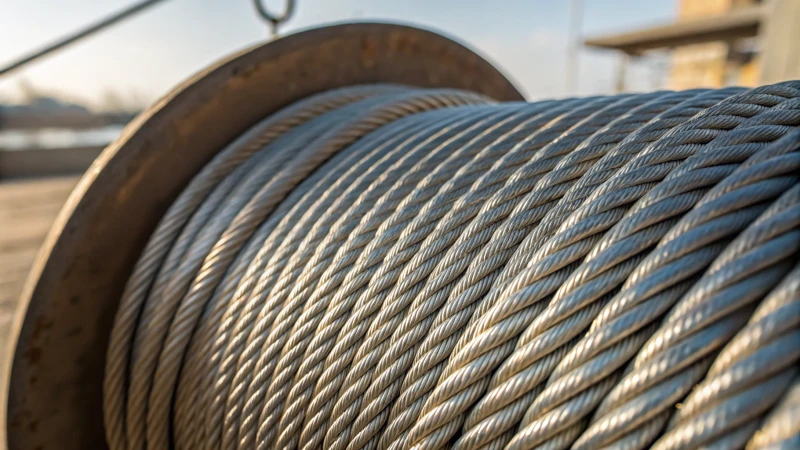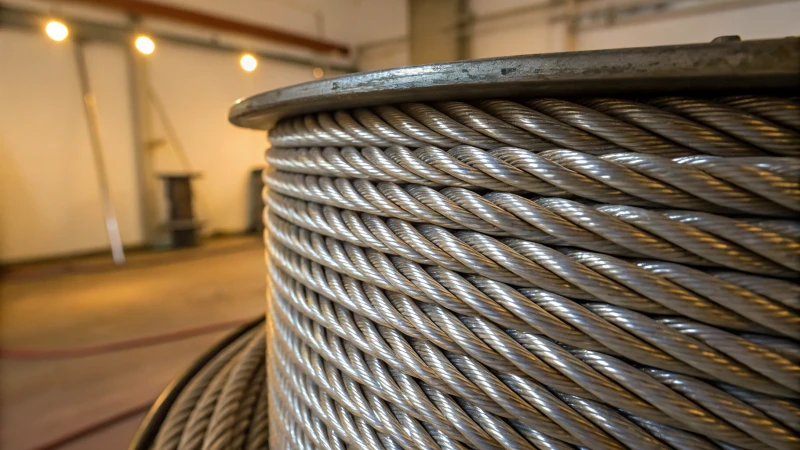
Ever wondered what makes steel wire ropes the backbone of heavy machinery?
The key manufacturing processes for steel wire rope involve wire drawing to achieve precise thickness, heat treatment for enhanced strength and wear resistance, and advanced coating techniques for durability. These steps ensure that steel wire ropes can endure the rigorous demands of heavy machinery applications.
I remember the first time I toured a steel wire rope manufacturing plant. The sheer complexity of the process amazed me. Wire drawing was like watching a sculptor in action, shaping raw steel into precise, strong strands. Then came the heat treatment—think of it as giving the steel a resilience boost, much like how a good workout strengthens muscles. Finally, the coating process, akin to adding armor to these ropes, ensures they can brave the harshest conditions.
Understanding these intricate steps makes me appreciate the innovation behind each strand. It's not just about crafting a product but engineering trust and safety into every meter of rope, ready to lift, pull, and withstand whatever challenges heavy machinery might face.
Wire drawing shapes steel wire to desired thickness.True
Wire drawing involves reducing the diameter of wire to specific sizes.
Coating technology reduces the tensile strength of steel ropes.False
Coating improves durability without compromising tensile strength.
How Does Wire Drawing Enhance Steel Wire Rope Performance?
Ever wondered how steel wire ropes get their impressive strength and flexibility? The secret lies in a process called wire drawing.
Wire drawing transforms steel wire ropes by enhancing their microstructure, boosting tensile strength, and increasing flexibility. This involves reducing the wire's diameter through dies, aligning its grain structure for stronger, more resilient ropes.

The Process of Wire Drawing
When I first learned about wire drawing, it was like peering into a world of intricate craftsmanship. Imagine taking a robust piece of steel and gently pulling it through a series of precisely engineered dies, each one smaller than the last. This cold working technique1 isn't just about making the wire thinner—it's about transforming it from the inside out. As the wire stretches and reshapes, its grain structure begins to align, much like how a team comes together when each member knows their role. This alignment is what boosts its mechanical properties, turning a simple wire into a powerhouse of strength and durability.
Impact on Tensile Strength and Flexibility
I remember the first time I saw a crane lifting an impossibly heavy load with ease, thanks to these enhanced steel ropes. The secret? Wire drawing significantly increases tensile strength by aligning the grains within the wire. This alignment is essential for applications demanding high-strength ropes—think construction cranes2 lifting beams into place or mining operations deep underground. Plus, there's the added benefit of improved flexibility, crucial for environments where the ropes bend and twist repeatedly yet need to remain strong.
Microstructure Refinement
During the drawing process, I've seen firsthand how the steel's microstructure refines itself. This isn't just about cosmetic changes; it's about reducing internal defects and ensuring uniformity across the wire's length. The result is a rope that not only stands up to stress better but also boasts enhanced resistance to wear and fatigue.
| Property | Before Drawing | After Drawing |
|---|---|---|
| Tensile Strength | Moderate | High |
| Flexibility | Limited | Enhanced |
| Grain Structure | Random | Aligned |
Application in Various Industries
I’ve always been fascinated by how industries like mining and construction rely on this process for operational reliability. Take mining operations3, for instance, where ropes endure high loads and abrasive environments. It's the wire drawing that ensures these ropes can handle such demanding conditions consistently.
Importance of Precision in Wire Drawing
Precision in wire drawing is something I deeply appreciate. Each pass through a die needs meticulous control to maintain uniformity. With advances in automation technologies4, this precision has reached new heights, resulting in products that meet stringent safety and performance standards with minimal variability.
Wire drawing increases steel wire tensile strength.True
Wire drawing aligns grain structure, enhancing tensile strength.
Wire drawing reduces the flexibility of steel wires.False
Wire drawing actually improves flexibility by refining microstructure.
How Does Heat Treatment Enhance Steel Wire Rope?
Ever wonder what makes steel wire ropes so incredibly strong and reliable? Well, the secret lies in a fascinating process called heat treatment. This technique is the unsung hero behind the durability and strength of these essential tools in construction, mining, and more.
Heat treatment enhances steel wire rope strength by modifying its microstructure to boost tensile strength, hardness, and wear resistance. This involves carefully controlled heating and cooling to refine grain structure and eliminate internal stresses.

Understanding Heat Treatment in Steel Wire Ropes
When I first started learning about steel wire ropes, I was amazed at how much their strength and durability depend on a process called heat treatment. It's not just about making metal hot and then cooling it off—it's about precision and science working together to enhance performance.
Annealing
Annealing was a game-changer for me. Imagine steel wire ropes needing the flexibility to wrap around pulleys without snapping. Annealing takes care of that by gently heating the steel to a certain temperature before letting it cool slowly. This reduces hardness and improves ductility, making the ropes resilient yet flexible.
Quenching and Tempering
Quenching reminds me of diving into a cold pool on a hot day—it rapidly cools down heated steel using water or oil, which boosts hardness. But there's a catch: too much hardness can make it brittle. That's where tempering steps in, reheating the quenched steel at lower temperatures to add toughness without losing tensile strength.
| Process | Purpose | Outcome |
|---|---|---|
| Annealing | Reduce hardness | Increased ductility |
| Quenching | Increase hardness | High tensile strength |
| Tempering | Improve toughness | Enhanced durability |
The Benefits of Heat Treatment
- Enhanced Tensile Strength: Heat-treated steel wire ropes5 can take on heavier loads without bending under pressure—a lifesaver on construction sites.
- Improved Wear Resistance: With a refined grain structure, these ropes stand up better against friction and abrasion.
- Stress Relief: By smoothing out internal tensions, heat treatment helps prevent unexpected breakages, giving you peace of mind.
For anyone like me who has seen these ropes in action in challenging environments like construction or mining, understanding the magic behind heat treatment is crucial. It ensures that when you're selecting the right steel wire ropes6 for your project, you're not just picking any rope—you're choosing reliability, safety, and performance that meet your operational requirements7.
Annealing reduces steel wire rope hardness.True
Annealing involves slow cooling, which reduces hardness and improves ductility.
Quenching increases the brittleness of steel.True
Rapid cooling in quenching increases hardness but can make steel brittle.
Why Is Coating Technology Essential for Steel Wire Ropes?
Ever wonder how steel wire ropes withstand harsh conditions without giving in?
Coating technology is crucial for steel wire ropes because it acts as a shield against corrosion, abrasion, and environmental elements. This protective layer significantly extends the lifespan of the ropes, ensuring they perform reliably even in challenging situations.

Understanding Coating Technology's Role
Steel wire ropes are the unsung heroes in industries like construction and mining, bearing the weight of responsibility—literally. I remember the first time I witnessed the transformation a simple coating could make. It was at a bustling construction site where the ropes faced relentless weather changes. The difference was night and day; coated ropes showed no signs of rust or wear, unlike their bare counterparts.
Coating technology is like putting on protective armor. Imagine sending a knight into battle without his shield—that's what uncoated ropes face against corrosion and abrasion. Here’s how different coatings come to the rescue:
- Corrosion Resistance: Zinc or epoxy coatings fend off rust, crucial for marine or humid environments where moisture is the enemy.
- Abrasion Protection: These coatings reduce wear and tear, especially when ropes are constantly rubbing against surfaces.
| Coating Type | Primary Benefit |
|---|---|
| Zinc | Corrosion resistance |
| Epoxy | Enhanced durability |
| PVC | Flexibility & protection |
Different Types of Coatings
When it comes to choosing coatings, it's all about matching them to the job at hand. I recall a project in the mining sector where we opted for galvanized coatings8 to prevent rusting. We needed ropes that could handle tough conditions, and boy, did they deliver! Galvanized coatings provide that extra layer of protection we needed.
For situations demanding more flexibility yet strong protection, PVC coatings were our go-to. In a study on mining operations, I was amazed to see that nylon-coated ropes9 lasted 30% longer than those without any coating.
Industry Applications
In construction, safety and performance are non-negotiable. Coated ropes are like the backbone of cranes, standing up to not only physical damage but also chemical exposure. I’ve seen firsthand how crucial these coatings are during high-stakes operations. Learn more about construction applications10.
Each industry has its own unique needs. In mining, ropes must withstand extreme stress and heavy loads. For marine environments, it’s all about battling saltwater exposure.
Choosing the right coating can drastically cut down maintenance costs and downtime—something I always emphasize when discussing the benefits with colleagues. As technology advances, nanotechnology11 is paving new paths, promising even more robust solutions in the future.
Zinc coatings prevent rust on steel wire ropes.True
Zinc acts as a protective layer, preventing rust in humid environments.
PVC coatings reduce the flexibility of steel ropes.False
PVC coatings enhance flexibility while providing protection.
How Does Automation Improve Steel Wire Rope Manufacturing Efficiency?
Have you ever wondered how automation transforms the way steel wire ropes are made, making them stronger and more reliable?
Automation in steel wire rope manufacturing boosts efficiency by streamlining processes, minimizing errors, and ensuring consistent quality. This tech upgrade leads to faster production cycles and lower costs.

Streamlining Production Processes
Imagine walking into a bustling factory where everything is synchronized like a well-oiled machine. That's what automation brings to steel wire rope manufacturing. Each stage, from wire drawing12 to heat treatment, becomes a seamless part of a larger symphony. With automated machinery, we achieve precision in specifications, ensuring every rope meets exacting standards.
- Wire Drawing: Here’s where the magic happens—automation ensures uniform diameter and tensile strength, resulting in top-notch products.
- Heat Treatment: Consistent temperatures are maintained, boosting durability and wear resistance.
Minimizing Human Error
I remember the days when human error led to unexpected defects—frustrating for everyone involved. Now, advanced control systems act as vigilant overseers, monitoring every parameter in real-time. Automation minimizes these errors, translating into superior product quality.
- Quality Control: Automated inspections catch deviations early on, saving us from costly reworks.
- Efficiency Monitoring: Real-time adjustments are made to keep everything running smoothly.
Enhancing Safety Standards
Safety has always been my top priority. With automation, we've significantly reduced manual handling and exposure to dangerous conditions. Automated systems help us comply with rigorous safety regulations, safeguarding our team.
- Robotic Handling: Robots take over heavy lifting, reducing injury risks.
- Safety Compliance: Automated checks ensure we never miss a beat on safety standards.
Increasing Production Speed
I’ve witnessed firsthand how automation supercharges our production speed. Automated machines work tirelessly, cutting down on downtime and boosting our capacity to deliver.
- Continuous Operation: Machines operate non-stop, pushing productivity to new heights.
- Rapid Prototyping: We quickly adapt to new designs, speeding up product development.
Cost Reduction
Though the initial investment in automation was hefty, the long-term savings have been immense. We've seen labor costs decrease and efficiency soar, giving us an excellent return on investment.
| Cost Factor | Impact of Automation |
|---|---|
| Labor Costs | Reduced due to fewer manual tasks |
| Material Waste | Minimized through precise controls |
| Maintenance Costs | Lower due to predictive maintenance |
| Downtime | Reduced with continuous operations |
Incorporating automation into steel wire rope manufacturing has been a game-changer. From efficiency boosts and error reduction to enhanced safety and cost savings, these advancements position us for growth and competitiveness. Embracing this technological shift is not just about staying afloat—it's about leading the charge into the future.
Automation reduces human error in steel wire rope manufacturing.True
Automation uses advanced control systems, minimizing human error and defects.
Automated machines increase downtime in steel wire production.False
Automation minimizes downtime by allowing continuous operation of machines.
Conclusion
Steel wire ropes are manufactured through wire drawing, heat treatment, and coating processes, enhancing strength, flexibility, and durability for heavy machinery applications in demanding environments.
-
Discover how cold working techniques refine metal properties for enhanced durability and performance. ↩
-
Learn about the specifications required for steel wire ropes used in construction cranes. ↩
-
Explore how steel wire ropes are utilized in mining operations for their strength and durability. ↩
-
Understand how automation improves precision and consistency in the wire drawing process. ↩
-
Explore how heat-treated steel wire ropes excel in heavy-duty applications due to increased strength and durability. ↩
-
Explore how heat-treated steel wire ropes excel in heavy-duty applications due to increased strength and durability. ↩
-
Understand the critical properties of steel wire ropes required for demanding construction environments. ↩
-
Discover how galvanized coatings enhance the lifespan and performance of steel wire ropes, especially in corrosive environments. ↩
-
Learn about the advantages of nylon coatings in extending the durability and reducing abrasion of steel wire ropes. ↩
-
Find out how coated steel wire ropes are utilized in construction, focusing on safety and performance benefits. ↩
-
Explore the potential of nanotechnology to revolutionize coatings for enhanced performance and durability. ↩
-
Learn about how automation improves precision and consistency in wire drawing. ↩

